Comprehensive Report on Liver: Anatomy, Function, and Diseases Biology
VerifiedAdded on 2022/09/10
|6
|988
|18
Report
AI Summary
This report offers a detailed exploration of the human liver, beginning with its gross and microscopic anatomy, including the structure of hepatic lobules, hepatocytes, and the portal triad. It then delves into the diverse functions of the liver, such as its role in metabolism, digestion, and detoxification, including the production of bile and its involvement in the processing of sugars, proteins, and fats. The report also addresses various liver diseases, including hepatitis, liver cancer, cirrhosis, and fatty liver disease, discussing their causes and implications. The document references key sources to support the information presented, providing a comprehensive overview of this vital organ and its significance in human health.

Running Head: LIVER
LIVER
Name
Professor
Institution
Course
Date
LIVER
Name
Professor
Institution
Course
Date
Paraphrase This Document
Need a fresh take? Get an instant paraphrase of this document with our AI Paraphraser
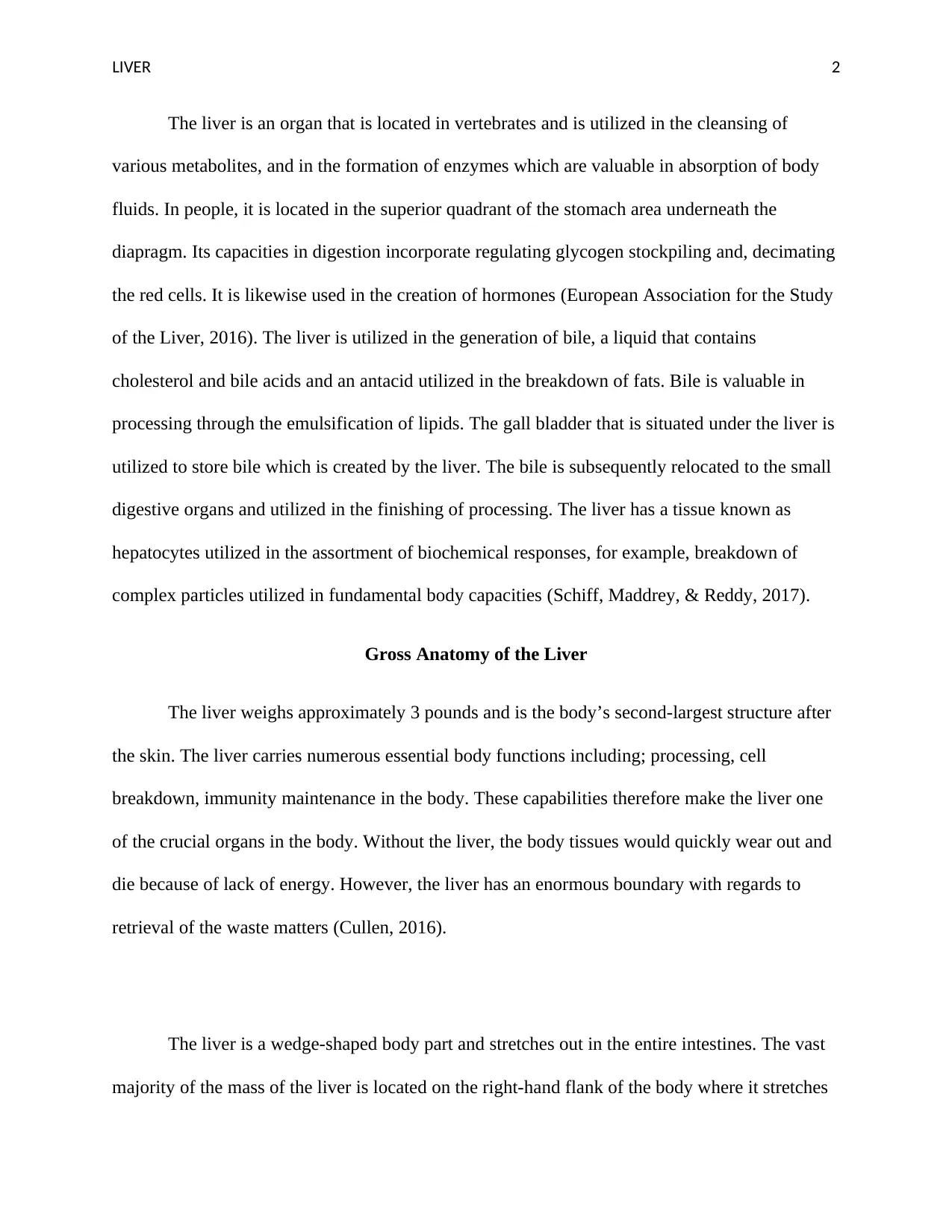
LIVER 2
The liver is an organ that is located in vertebrates and is utilized in the cleansing of
various metabolites, and in the formation of enzymes which are valuable in absorption of body
fluids. In people, it is located in the superior quadrant of the stomach area underneath the
diapragm. Its capacities in digestion incorporate regulating glycogen stockpiling and, decimating
the red cells. It is likewise used in the creation of hormones (European Association for the Study
of the Liver, 2016). The liver is utilized in the generation of bile, a liquid that contains
cholesterol and bile acids and an antacid utilized in the breakdown of fats. Bile is valuable in
processing through the emulsification of lipids. The gall bladder that is situated under the liver is
utilized to store bile which is created by the liver. The bile is subsequently relocated to the small
digestive organs and utilized in the finishing of processing. The liver has a tissue known as
hepatocytes utilized in the assortment of biochemical responses, for example, breakdown of
complex particles utilized in fundamental body capacities (Schiff, Maddrey, & Reddy, 2017).
Gross Anatomy of the Liver
The liver weighs approximately 3 pounds and is the body’s second-largest structure after
the skin. The liver carries numerous essential body functions including; processing, cell
breakdown, immunity maintenance in the body. These capabilities therefore make the liver one
of the crucial organs in the body. Without the liver, the body tissues would quickly wear out and
die because of lack of energy. However, the liver has an enormous boundary with regards to
retrieval of the waste matters (Cullen, 2016).
The liver is a wedge-shaped body part and stretches out in the entire intestines. The vast
majority of the mass of the liver is located on the right-hand flank of the body where it stretches
The liver is an organ that is located in vertebrates and is utilized in the cleansing of
various metabolites, and in the formation of enzymes which are valuable in absorption of body
fluids. In people, it is located in the superior quadrant of the stomach area underneath the
diapragm. Its capacities in digestion incorporate regulating glycogen stockpiling and, decimating
the red cells. It is likewise used in the creation of hormones (European Association for the Study
of the Liver, 2016). The liver is utilized in the generation of bile, a liquid that contains
cholesterol and bile acids and an antacid utilized in the breakdown of fats. Bile is valuable in
processing through the emulsification of lipids. The gall bladder that is situated under the liver is
utilized to store bile which is created by the liver. The bile is subsequently relocated to the small
digestive organs and utilized in the finishing of processing. The liver has a tissue known as
hepatocytes utilized in the assortment of biochemical responses, for example, breakdown of
complex particles utilized in fundamental body capacities (Schiff, Maddrey, & Reddy, 2017).
Gross Anatomy of the Liver
The liver weighs approximately 3 pounds and is the body’s second-largest structure after
the skin. The liver carries numerous essential body functions including; processing, cell
breakdown, immunity maintenance in the body. These capabilities therefore make the liver one
of the crucial organs in the body. Without the liver, the body tissues would quickly wear out and
die because of lack of energy. However, the liver has an enormous boundary with regards to
retrieval of the waste matters (Cullen, 2016).
The liver is a wedge-shaped body part and stretches out in the entire intestines. The vast
majority of the mass of the liver is located on the right-hand flank of the body where it stretches
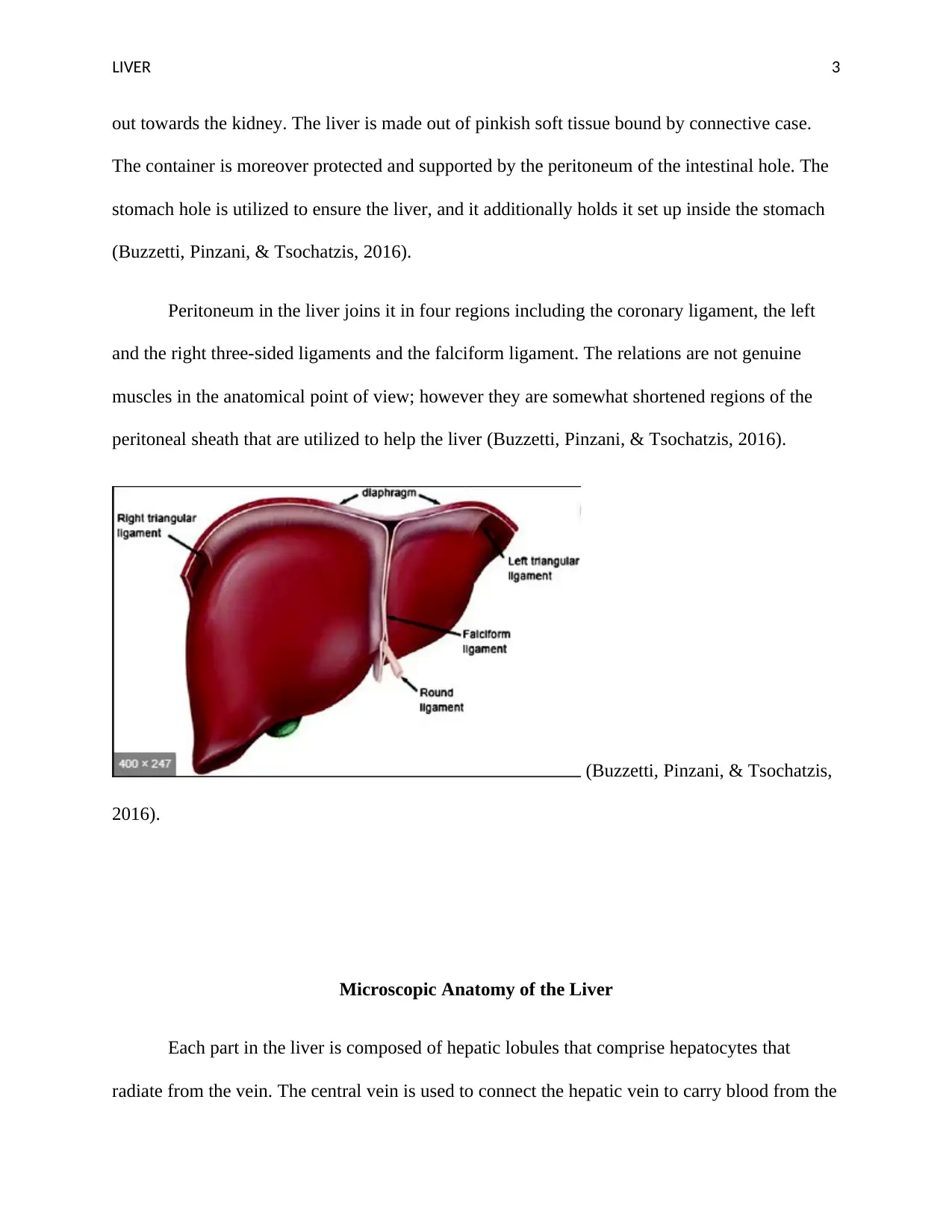
LIVER 3
out towards the kidney. The liver is made out of pinkish soft tissue bound by connective case.
The container is moreover protected and supported by the peritoneum of the intestinal hole. The
stomach hole is utilized to ensure the liver, and it additionally holds it set up inside the stomach
(Buzzetti, Pinzani, & Tsochatzis, 2016).
Peritoneum in the liver joins it in four regions including the coronary ligament, the left
and the right three-sided ligaments and the falciform ligament. The relations are not genuine
muscles in the anatomical point of view; however they are somewhat shortened regions of the
peritoneal sheath that are utilized to help the liver (Buzzetti, Pinzani, & Tsochatzis, 2016).
(Buzzetti, Pinzani, & Tsochatzis,
2016).
Microscopic Anatomy of the Liver
Each part in the liver is composed of hepatic lobules that comprise hepatocytes that
radiate from the vein. The central vein is used to connect the hepatic vein to carry blood from the
out towards the kidney. The liver is made out of pinkish soft tissue bound by connective case.
The container is moreover protected and supported by the peritoneum of the intestinal hole. The
stomach hole is utilized to ensure the liver, and it additionally holds it set up inside the stomach
(Buzzetti, Pinzani, & Tsochatzis, 2016).
Peritoneum in the liver joins it in four regions including the coronary ligament, the left
and the right three-sided ligaments and the falciform ligament. The relations are not genuine
muscles in the anatomical point of view; however they are somewhat shortened regions of the
peritoneal sheath that are utilized to help the liver (Buzzetti, Pinzani, & Tsochatzis, 2016).
(Buzzetti, Pinzani, & Tsochatzis,
2016).
Microscopic Anatomy of the Liver
Each part in the liver is composed of hepatic lobules that comprise hepatocytes that
radiate from the vein. The central vein is used to connect the hepatic vein to carry blood from the
You're viewing a preview
Unlock full access by subscribing today!
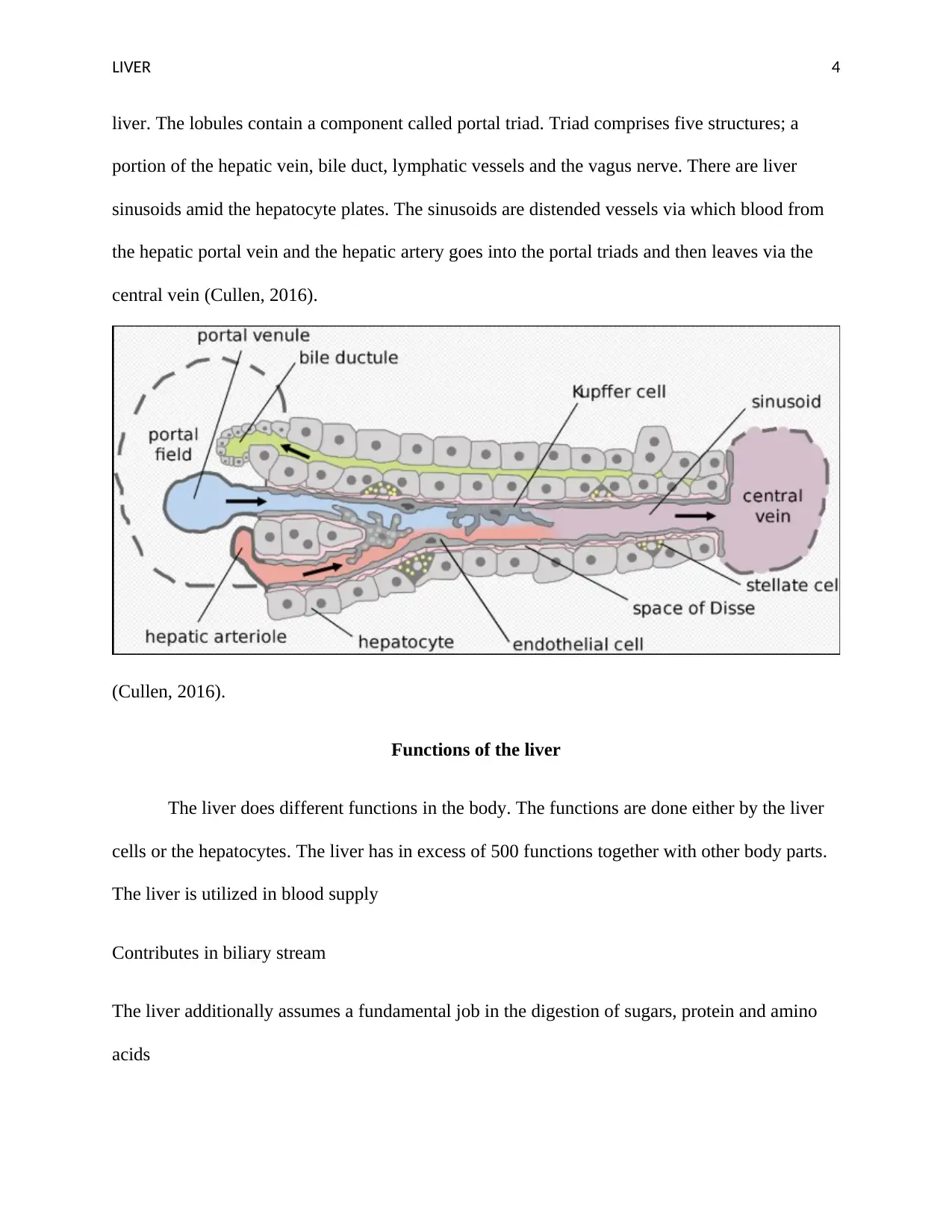
LIVER 4
liver. The lobules contain a component called portal triad. Triad comprises five structures; a
portion of the hepatic vein, bile duct, lymphatic vessels and the vagus nerve. There are liver
sinusoids amid the hepatocyte plates. The sinusoids are distended vessels via which blood from
the hepatic portal vein and the hepatic artery goes into the portal triads and then leaves via the
central vein (Cullen, 2016).
(Cullen, 2016).
Functions of the liver
The liver does different functions in the body. The functions are done either by the liver
cells or the hepatocytes. The liver has in excess of 500 functions together with other body parts.
The liver is utilized in blood supply
Contributes in biliary stream
The liver additionally assumes a fundamental job in the digestion of sugars, protein and amino
acids
liver. The lobules contain a component called portal triad. Triad comprises five structures; a
portion of the hepatic vein, bile duct, lymphatic vessels and the vagus nerve. There are liver
sinusoids amid the hepatocyte plates. The sinusoids are distended vessels via which blood from
the hepatic portal vein and the hepatic artery goes into the portal triads and then leaves via the
central vein (Cullen, 2016).
(Cullen, 2016).
Functions of the liver
The liver does different functions in the body. The functions are done either by the liver
cells or the hepatocytes. The liver has in excess of 500 functions together with other body parts.
The liver is utilized in blood supply
Contributes in biliary stream
The liver additionally assumes a fundamental job in the digestion of sugars, protein and amino
acids
Paraphrase This Document
Need a fresh take? Get an instant paraphrase of this document with our AI Paraphraser
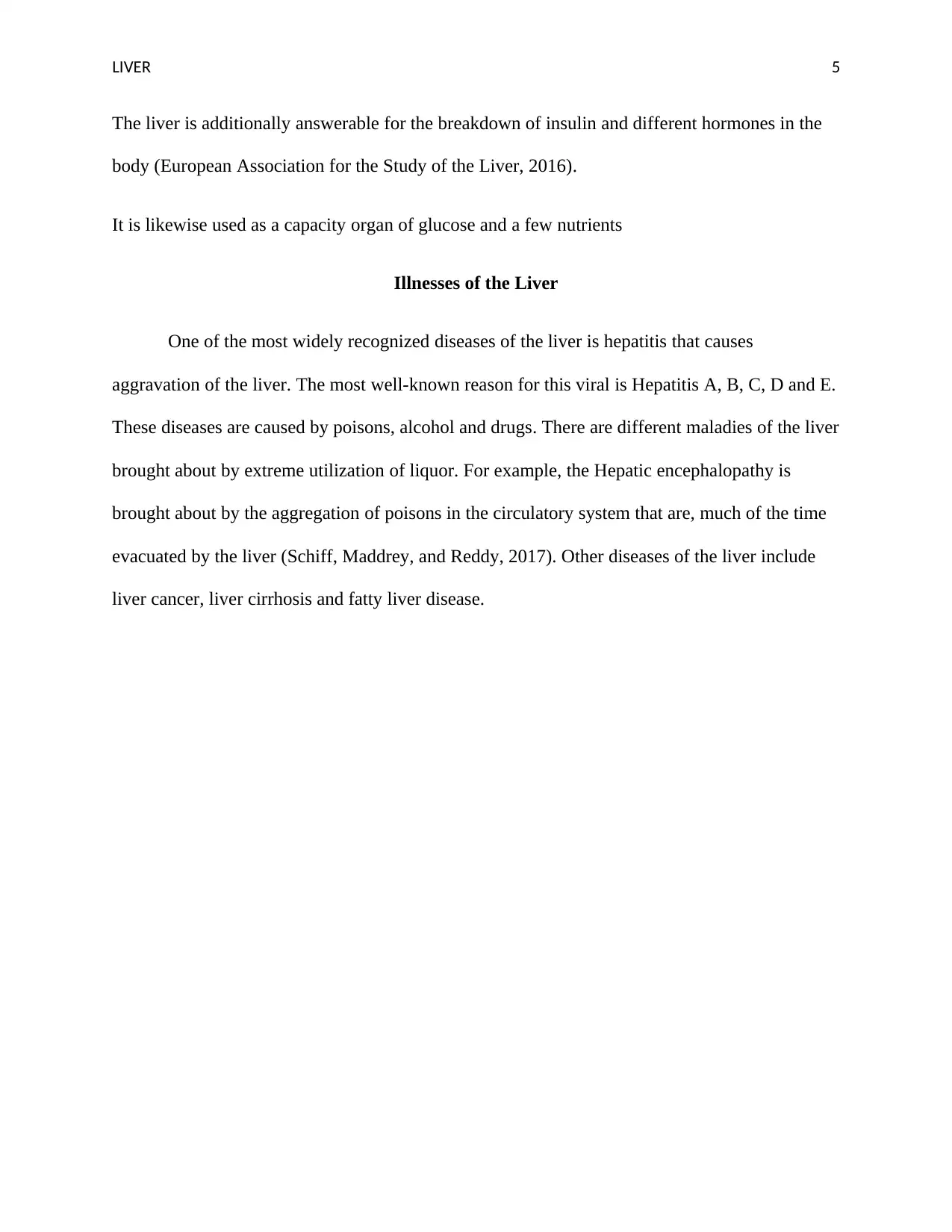
LIVER 5
The liver is additionally answerable for the breakdown of insulin and different hormones in the
body (European Association for the Study of the Liver, 2016).
It is likewise used as a capacity organ of glucose and a few nutrients
Illnesses of the Liver
One of the most widely recognized diseases of the liver is hepatitis that causes
aggravation of the liver. The most well-known reason for this viral is Hepatitis A, B, C, D and E.
These diseases are caused by poisons, alcohol and drugs. There are different maladies of the liver
brought about by extreme utilization of liquor. For example, the Hepatic encephalopathy is
brought about by the aggregation of poisons in the circulatory system that are, much of the time
evacuated by the liver (Schiff, Maddrey, and Reddy, 2017). Other diseases of the liver include
liver cancer, liver cirrhosis and fatty liver disease.
The liver is additionally answerable for the breakdown of insulin and different hormones in the
body (European Association for the Study of the Liver, 2016).
It is likewise used as a capacity organ of glucose and a few nutrients
Illnesses of the Liver
One of the most widely recognized diseases of the liver is hepatitis that causes
aggravation of the liver. The most well-known reason for this viral is Hepatitis A, B, C, D and E.
These diseases are caused by poisons, alcohol and drugs. There are different maladies of the liver
brought about by extreme utilization of liquor. For example, the Hepatic encephalopathy is
brought about by the aggregation of poisons in the circulatory system that are, much of the time
evacuated by the liver (Schiff, Maddrey, and Reddy, 2017). Other diseases of the liver include
liver cancer, liver cirrhosis and fatty liver disease.
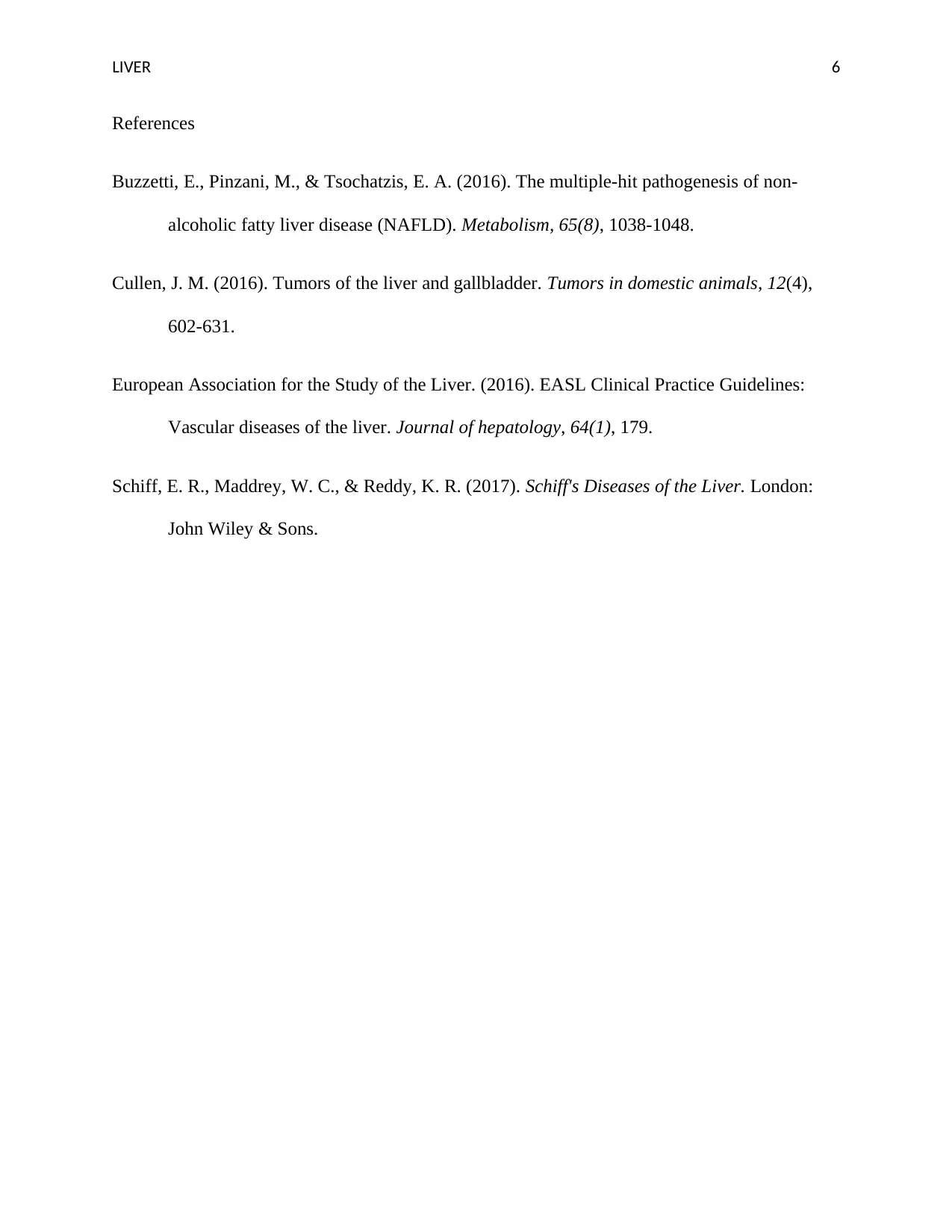
LIVER 6
References
Buzzetti, E., Pinzani, M., & Tsochatzis, E. A. (2016). The multiple-hit pathogenesis of non-
alcoholic fatty liver disease (NAFLD). Metabolism, 65(8), 1038-1048.
Cullen, J. M. (2016). Tumors of the liver and gallbladder. Tumors in domestic animals, 12(4),
602-631.
European Association for the Study of the Liver. (2016). EASL Clinical Practice Guidelines:
Vascular diseases of the liver. Journal of hepatology, 64(1), 179.
Schiff, E. R., Maddrey, W. C., & Reddy, K. R. (2017). Schiff's Diseases of the Liver. London:
John Wiley & Sons.
References
Buzzetti, E., Pinzani, M., & Tsochatzis, E. A. (2016). The multiple-hit pathogenesis of non-
alcoholic fatty liver disease (NAFLD). Metabolism, 65(8), 1038-1048.
Cullen, J. M. (2016). Tumors of the liver and gallbladder. Tumors in domestic animals, 12(4),
602-631.
European Association for the Study of the Liver. (2016). EASL Clinical Practice Guidelines:
Vascular diseases of the liver. Journal of hepatology, 64(1), 179.
Schiff, E. R., Maddrey, W. C., & Reddy, K. R. (2017). Schiff's Diseases of the Liver. London:
John Wiley & Sons.
You're viewing a preview
Unlock full access by subscribing today!
1 out of 6
Your All-in-One AI-Powered Toolkit for Academic Success.
+13062052269
info@desklib.com
Available 24*7 on WhatsApp / Email
![[object Object]](/_next/static/media/star-bottom.7253800d.svg)
Unlock your academic potential
© 2024 | Zucol Services PVT LTD | All rights reserved.